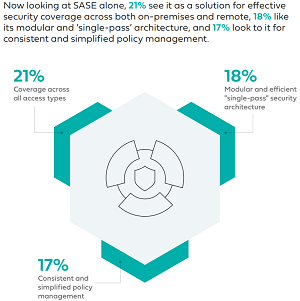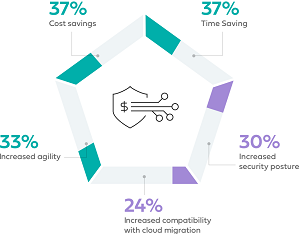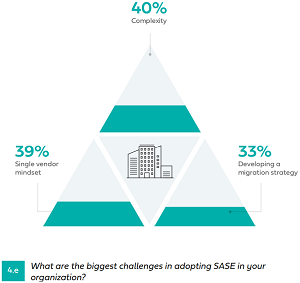News
Networking/Security Convergence with SASE Marked in New Report
The convergence of networking and security via secure access service edge (SASE) architectures is tracked in a new survey-based report from Aryaka, a managed SD-WAN services provider.
That convergence is one of four main themes of the company's sixth annual "Global State of the WAN Report" just published for 2022. The survey asked respondents about their networking and performance challenges, priorities and their plans for 2022 and beyond.
The driving factor of the networking/security convergence is said to be simplification as organizations adopt a more cloud-centric and agile approach.
"The road to SASE is promising but there are genuine concerns," the company said in a Jan. 19 blog post announcing the report. "Since this topic is top of mind, it is worth mentioning that at least the promise of the SASE architecture is compelling."
According to Wikipedia, that SASE architecture "is architected to provide consistent fast, secure access to any resource from any entity at any location, as opposed to access primarily based on the corporate data center." Expected benefits include reduced complexity, universal access, cost efficiency, performance, ease of use and consistent security, the site adds.
That list of expected benefits jives with answers from survey respondents who were asked "What is the primary reason you have already deployed or would consider deploying SASE?" The top answers were: coverage across all access types; modular and efficient "single-pass" security architectures; and consistent and simplified policy management, as this graphic shows:
 [Click on image for larger view.] "What is the primary reason you have already deployed or would consider deploying SASE?" (source: Aryaka).
[Click on image for larger view.] "What is the primary reason you have already deployed or would consider deploying SASE?" (source: Aryaka).
Expected benefits are led by time savings, cost savings and increased agility.
 [Click on image for larger view.] "If already deployed, what are the biggest benefits of your SASE deployment?" (source: Aryaka).
[Click on image for larger view.] "If already deployed, what are the biggest benefits of your SASE deployment?" (source: Aryaka).
On the flip side, as always, are concerns and barriers.
"Global organizations recognize [SASE] is the future, but not all are sure how to get there. Implementation timelines, the decision maker's role and the approach to SASE vary by company size and region, but all organizations share the top two concerns: complexity of management and high implementation costs," states the report, which is based on a survey of 1,600 enterprise decision makers and practitioners from around the world.
 [Click on image for larger view.] "What are the biggest challenges in adopting SASE in your organization." (source: Aryaka).
[Click on image for larger view.] "What are the biggest challenges in adopting SASE in your organization." (source: Aryaka).
The report summarizes much of the above and more data about the convergence trend in one paragraph:
"SASE represents a promise of a converged Cloud-First architecture, but there are concerns on complexity and adoption. 42 percent state that lackluster application performance is a time sink, and 34 percent consider security to be a major priority. This path to SASE adoption includes setting a strategy (35 percent ), phasing out of legacy VPNs (32 percent ), as well as consolidating cloud security with zero-trust (29 percent ). Top desired capabilities include a [Secure Web Gateway] (47 percent ), SD-WAN (36 percent ) and [Firewall as a service] (28 percent ). Implementation concerns identified earlier are balanced by expected advantages that include time and cost reduction (37 percent ), as well as agility (33 percent ), a while decision-making is still mostly distributed across networking and security, 41 percent state it is now consolidated. Finally, over two-thirds plan to consume SASE as a managed offer."
Beyond the convergence trend, other highlights of the report as listed by Aryaka include:
- A quarter of the respondents state they have closed 25-50 percent of their office sites, dovetailing into overall hybrid work initiatives where 75 percent state that at least a quarter of their employees will remain remote permanently post-pandemic.
- Accelerating digital transformation initiatives also impact legacy data centers, with 51 percent planning to eliminate their use within the next 24 months as they move to the cloud.
- The surveyed group says Microsoft Teams (58 percent ) and Office 365 (55 percent ) are among the most widely adopted SaaS applications, followed by Zoom and Google Docs (35 percent ).
- A quarter of respondents expect budgets to grow by 25 percent or more in the next year, with a full three-quarters projecting at least a 10 percent growth. Investment appears to be accompanied via cost savings.
The other three main themes of the report are summarized thusly:
- Acceleration of Remote and Hybrid Work: The report looks at challenges in supporting the hybrid workforce, hybrid work trends and investments planned to support this new environment. 75 percent state that at least a quarter of their employees will remain hybrid post-pandemic, aligned with the closure of physical facilities, with a quarter stating they have closed 25-50 percent of their office sites. Effectively managing worker movement between on-premises and remote requires dynamic bandwidth reallocation, identified by 61 percent as very important.
- Application Performance and Consumption: In addition, the report dives into the diversity of applications in use and resulting challenges, how enterprises plan to address these and potential concerns. As noted earlier, collaboration and productivity applications like Microsoft Teams and Office 365 experienced some of the strongest growth, but there was an overall uptick in SaaS application adoption including Zoom (35 percent ), Salesforce (28 percent ) and SAP/HANA (25 percent ). Performance still must improve, with 42 percent identifying slow performance for remote and mobile users a key issue, followed by 37 percent calling out slow performance at the branch.
- Managing Complexity and Managed Services Adoption: The report addresses what managed services enterprises expect, including SD-WAN and SASE implementation plans and budgets, as well as perceived barriers to adoption. This section also looks at MPLS migration. In evaluating managed services, enterprises continue to demand more from their providers, and are looking for a wider set of offers, an all-in-one SD-WAN and SASE that includes the WAN (45 percent ), security (67 percent ), application optimization (40 percent ), last mile management (29 percent ) and multi-cloud connectivity (27 percent ). The movement to SD-WAN and SASE also follows the movement away from MPLS, with 46 percent planning to terminate some or all contracts over the next year. Enterprises are generally bullish on their budgets, with a quarter are expecting it to grow by 25 percent or more, and a total of three quarters expecting at lease 10 percent growth.
"This year's Aryaka State of the WAN includes many valuable insights backing up trends we see in the industry," Aryaka quoted Scott Raynovich, founder and chief analyst of Futuriom, as saying. "These include the effects of hybrid work, with 75 percent projecting a quarter of their employees to remain at least part-time remote, and cloud connectivity demands skyrocketing with 51 percent planning to move away from traditional data centers over the next two years. Both initiatives will require more sophisticated network-as-a-service (NaaS) solutions with integrated security offerings."
Aryaka recently announced "all-in-one" SD-WAN and SASE offerings.
About the Author
David Ramel is an editor and writer at Converge 360.